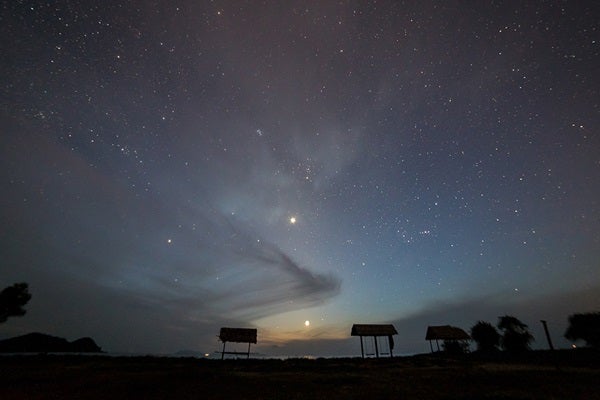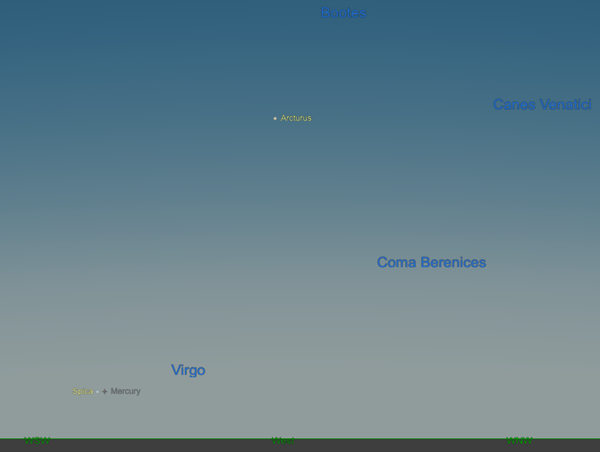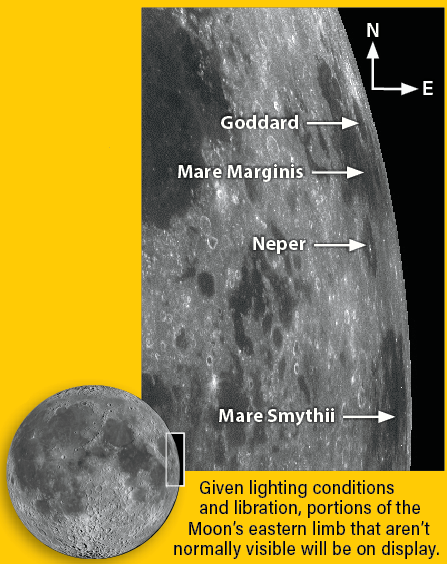Observers with medium to large telescopes will want to point at magnitude 4 Saturn this evening. Several of the ringed planet’s moons are lined up nicely tonight: Tethys and Enceladus sit east of Saturn, while Mimas, Dione, and Rhea stretch out to the west. Brighter Titan sits about 1.5′ northeast of the planet and is visible with smaller scopes.
Similarly, Saturn’s brilliant rings are within reach a small telescope or even large binoculars. They stretch 40″ across and keen-eyed observers may spot the shadow of the planet darkening the rings off the eastern limb. Thanks to a slim Moon, the sky should be dark; if you’ve got good observing conditions, spend some time watching the planet’s 18″-wide disk for subtle variations in its atmosphere. Although Jupiter’s cloud bands and belts are typically easier to discern, Saturn, too, often shows variations in color among its cloud tops.
Sunrise*: 6:44 A.M.
Sunset: 7:03 P.M.
Moonrise: 7:59 A.M.
Moonset: 8:12 P.M.
Moon Phase: Waxing crescent (3%)
*Times for sunrise, sunset, moonrise, and moonset are given in local time from 40° N 90° W. The Moon’s illumination is given at 12 P.M. local time from the same location.
Saturday, September 19
Thanks to the recent discovery of phosphine in its atmosphere, the planet Venus has enjoyed some time in the limelight. You can get in on the excitement early this morning by looking for Earth’s sister planet in the eastern sky before dawn. An hour before sunrise, Venus is 27° high; it’s located in Cancer the Crab and shining a brilliant magnitude –4.2. Through a telescope, you’ll see that the planet’s disk is 67 percent lit and spans 17″. If you return to the planet throughout the rest of the month, you’ll see it grow to 71 percent lit but shrink a bit to close out September with a diameter of 16″.
Cancer itself is a relatively small, dim constellation, but recognizable bright stars in this region of the sky include Regulus in Leo, Castor and Pollux in Gemini, and Procyon in Canis Minor. Follow a line from the horizon upward through Venus, then continue craning your head up along the same line to spot bright Capella in Auriga, nearly directly overhead.
Sunrise: 6:45 A.M.
Sunset: 7:01 P.M.
Moonrise: 9:14 A.M.
Moonset: 8:43 P.M.
Moon Phase: Waxing crescent (8%)
Sunday, September 20
If you’re up for another early morning viewing session, return to the eastern sky before dawn and locate Venus once more. Then look with binoculars or a small telescope 2.5° northeast of the planet to locate asteroid 4 Vesta, a dim magnitude 8 object far outshined by the planet’s blazing light.
Venus currently sits nearly the same distance from Earth as Earth is from the Sun, while Vesta (located in the asteroid belt between Mars and Jupiter) is nearly three times that distance from Earth. And although Venus is just slightly smaller than our planet, Vesta is a mere 330 miles (530 kilometers) across. It’s nearly — but not quite — round, and is the largest body in the main belt, after 1 Ceres (which we’ll visit later this week).
Both Venus and Vesta will be visible together in the same field of view most of this week, before they diverge as the closer (and thus faster-moving) planet overtakes the more distant asteroid, leaving it behind.
Sunrise: 6:46 A.M.
Sunset: 6:59 P.M.
Moonrise: 10:30 A.M.
Moonset: 9:18 P.M.
Moon Phase: Waxing crescent (15%)
The planet Mercury and the bright star Spica stand side by side in Virgo this evening. They’re only about 0.6° apart; magnitude 1 Spica is left of the magnitude –0.1 planet. You’ll need to be quick if you want to catch the pair, though — start searching for them in the west right after sunset, when they’re already quickly sinking toward the horizon. By 20 minutes after sunset, they’re only about 4.5° high. Mercury will pass 0.3° north of Spica at 5 A.M. EDT, but the pair won’t be visible then.
Once Virgo disappears from the evening sky, look east past Libra and into Scorpius to find the waxing crescent Moon. Nearby is bright red Antares, which depicts the star-studded Scorpion’s heart. After these sights have set, move your gaze further east still to find Jupiter and Saturn, shining near the Teapot of Sagittarius. The giant planets are now just under 8° apart; they will continue drawing closer over the next few months until they reach a spectacular close conjunction December 21.
Sunrise: 6:47 A.M.
Sunset: 6:58 P.M.
Moonrise: 11:45 A.M.
Moonset: 9:56 P.M.
Moon Phase: Waxing crescent (25%)
Tuesday, September 22
The autumnal equinox occurs this morning at 9:31 A.M. EDT. This marks the beginning of autumn in the Northern Hemisphere and the beginning of spring in the Southern Hemisphere.
Tonight after sunset, spend some time in Draco the Dragon, who sits high in the north. One of the largest constellations, Draco contains numerous deep-sky objects, including the magnitude 8 Cat’s Eye Nebula (NGC 6543) and the magnitude 10 Spindle Galaxy (M102). The Cat’s Eye is a planetary nebula formed by a dying Sun-like star; you’ll find it roughly halfway between Delta (δ) and Zeta (ζ) Draconis. The nebula’s center spans about 20″ and its bluish color can be seen with binoculars.
The Spindle is a bit trickier and you’ll want a telescope to see this edge-on spiral galaxy, which sits 4° southeast of Iota (ι) Draconis. Smaller scopes (4 inches) will reveal its elliptically shaped glow, while larger instruments might let you spot the dark dust lane down the galaxy’s middle.
While you’re in the region, make sure to glance at Thuban, Draco’s alpha star. This magnitude 3.7 luminary once served as Earth’s North Star, when our planet’s axis of rotation (which wobbles over time) pointed toward it instead of Polaris, our modern-day guidepost.
Sunrise: 6:46 A.M.
Sunset: 6:56 P.M.
Moonrise: 12:57 P.M.
Moonset: 10:39 P.M.
Moon Phase: Waxing crescent (35%)
First Quarter Moon occurs at 9:55 P.M. EDT tonight. Our satellite will be visible all evening, setting shortly before midnight.
Tonight is the perfect opportunity to observe a phenomenon called libration, which allows us to see our satellite from slightly different angles throughout the month. In this case, our viewing angle lets us to peek around the eastern limb of the Moon, revealing “extra” real estate between Mare Crisium and the visible edge of our satellite. More easily visible are features such as Mare Marginis and Mare Smythii, which normally appear as thin, dark channels but are now much broader, larger dark splotches. The crater Neper should also be easier to spot, as will Goddard to its northeast.
Return to this region of the Moon over the next few days to see how the viewpoint changes. By the time the Moon reaches Full, many of these features will have disappeared once more, having spun back beyond the limb from out point of view.
This NASA visualization shows our Moon’s phases throughout 2020; it also clearly shows the effects of lunar libration from month to month.
Sunrise: 6:49 A.M.
Sunset: 6:54 P.M.
Moonrise: 2:05 P.M.
Moonset: 11:30 P.M.
Moon Phase: Waxing crescent (46%)
Thursday, September 24
Comet 88P/Howell is a perfect early-evening target in Scorpius tonight. Remember Antares from earlier this week? Now you’ll want to return to the bright red star to look for Howell’s magnitude 9 glow nearby. An hour after sunset, Howell is about 1.5° northwest of Antares and less than 1° southwest of magnitude 2.9 Alniyat (Sigma [σ] Scorpii). Under dark skies, you should be able to nab the comet with a 4-inch scope, but bump up your aperture if you’re battling more light pollution.
Also nearby are several globular clusters: M80, M4, and NGC 6144. You’ll need a large field of view to spot all three — and the comet — at once, or you can scan from one to the next under higher power. Compare and contrast the comet’s coma with the clusters to see what differences you can spot with varying magnification.
Sunrise: 6:50 A.M.
Sunset: 6:53 P.M.
Moonrise: 3:05 P.M.
Moonset: —
Moon Phase: Waxing gibbous (57%)
Friday, September 25
The dwarf planet 1 Ceres passes within 5° of magnitude 6 Zeta Piscis Austrinus tonight. You can find the small, magnitude 7.7 world with binoculars or a small scope above the southern horizon. You’ll want to wait a few hours after sunset, letting the sky grow darker and the region where Ceres floats climb higher in the sky. If you have trouble determining which point of light is Ceres, don’t worry — simply take a snapshot or make a quick sketch of what you see, then return to this region over the next few days to determine which “star” has moved. That’s your target.
Nearby is Piscis Austrinus’ brightest star, Fomalhaut, which is famous in its own right. This young star’s seemingly strange name actually fits quite well — it’s adapted from a phrase that means “the mouth of the southern fish” in Arabic. Fomalhaut is nearly 450 million years old and roughly twice the mass of our own Sun. It also sports a large, dusty disk that astronomers believe is forming planets. Recently, however, the Hubble Space Telescope showed that the object astronomers had classified as a young planet was actually more likely the aftermath of a huge collision of icy objects — perhaps protoplanets themselves — in the disk.
Sunrise: 6:51 A.M.
Sunset: 6:51 P.M.
Moonrise: 3:57 P.M.
Moonset: 12:25 A.M.
Moon Phase: Waxing gibbous (67%)












